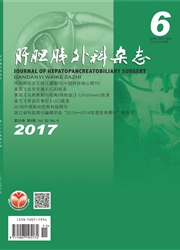

 中文摘要:
中文摘要:
目的探讨胆道镜下体内冲击波碎石治疗术后肝胆管残石的疗效与安全性。方法总结2005年4月至2008年3月间采用胆道镜下体内冲击波碎石治疗胆道术后残石患者48例(观察组)资料,同时收集2002年8月至2005年3间月连续就诊的纤维胆道镜治疗肝胆管残石患者50例(对照组)资料,比较分析两组结石取净率、并发症发生情况。结果观察组取净结石47例,1例肝内Ⅲ级胆管残石无法窥见取出,取净率97.9%;对照组取石成功38例,取净率76%,两组取净率差异有统计学意义(P〈0.01)。观察组有6例碎石后胆管黏膜有轻度渗血,对照组有5例,均经生理盐水冲洗后自行停止。观察组术后发生轻微急性胆管炎5例(占10.4%),对照组6例(占12%);取石后肝功能异常者,观察组6例,对照组8例,差异均无统计学意义(P〉0.01)。观察组随访6~18个月,无冲击波碎石相关的胆管狭窄发现。结论胆道镜下体内冲击波胆道碎石是治疗术后肝胆管残石的一种安全有效的方法。
 英文摘要:
英文摘要:
Objective To evaluate the efficacy and safety of the treatment of the postoperative residual hepatolithiasis using the internal shock-wave lithotripsy(ISWL) under choledochoscope.Methods The clinical data of 48 patients with postoperative residual hepatolithiasis from April 2005 to March 2008 treated with ISWL(experimental group) and 50 cases with hepatobiliary residual stone from August 2002 to March 2005 treated with choledochofiberscope were summarized and the stone clearance rate and complication occurrence rate between two groups were compared(control group).Results Except that 1 case of Ⅲ level of residual stone of intrahepatic bile ducts could not be removed,the stones in 47 patients in the experimental group were entirely removed with the clearance rate of 97.9%.ISWL was successfully performed in 38 cases(76%),there was significant difference between the two groups(P0.01).Postoperative mucosal slight errhysis of the bile duct occurred in six cases in the experimental group and in 5 cases of the control group,but the errhysis was automatically stopped with normal saline flush.After the operation,a mild acute cholangitis o-curred in 5 cases of the experimental group(10.4%) and 6 patients in the control group(12%),there was no significant difference between them(P0.01).After 6~18 months follow-up in the experimental group,no relevant bile duct stricture of shock-wave lithotripsy was found.Conclusion ISWL is a safe and effective method in the treatment of postoperative residual hepatolishiasis.
 同期刊论文项目
同期刊论文项目
 同项目期刊论文
同项目期刊论文
 期刊信息
期刊信息
